Luckily I didn’t take Klippel as the gold standard and question everything else. Instead I used one of its weaknesses for illustrative purposes. Plenty of skepticism here, don’t you worry.If you take Klippel as the gold standard to question everything else without understanding the underlying technologies, then this is not objectivity but a concerning lack of skepticism.
REW plot with post #1 shos distortion at fundamental. This means that eg. H3 at 200Hz could add spl at 600Hz. However distortion levels are so low that spl is identical.
Sorry I was a bit feisty, looneybomber. It was a very busy day.
How fast does the distortion rise with SPL? Does it stay about the same level with the other distortions?
How fast does the distortion rise with SPL? Does it stay about the same level with the other distortions?
Have you made sure that it is not actually the grill 'frame' vibrating or being affected that causes it?It can't really get much closer in this case. The cloth is stretched over a thin hoop made of white oak (steam bent) which fits snugly over the driver's front gasket.
Grill frames as mentioned before is a common source of diffraction, and 3rd harmonic from rattling/vibration etc.
Without trying with fabric only and check the difference, the measurements can't give a conclusion.
Did not see it mentioned by anyone else the Weltersys.
A rattle will cause a long series of harmonics including H6 and above, whereas here we see purely odd harmonics. Solid body contact effects are unlikely to cause purely odd harmonics.
Does supporting the grill cloth have an effect? If the cloth experiences nonlinear air resistance, then it becomes a radiating surface for odd harmonics. Supporting the cloth allows it to move less.
That would match @lrisbo's observation about movement of internal damping:
note also that damping material in the box can add distortion. this typically adds odd harmonics. Damping material should be 100% fastened and must not emit sound when rubbed/deformed. High density open cell foam works well.
You'll have to be more specific as to what kind of analysis you had in mind. To me, a "Fourier transform" with no other qualifiers just means the frequency-domain representation of the impulse response.It would still be interesting to see the Fourier transforms for a sampling of frequencies.
I'm fairly certain that the hoop is not the culprit. The other driver I measured was in a separate cabinet with a separate grille assembly (which happens to fit slightly looser), yet the results were virtually identical. No grille cloth:Have you made sure that it is not actually the grill 'frame' vibrating or being affected that causes it?
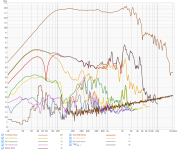
With grille cloth:
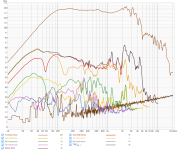
The relative microphone position is not identical to the plots in post #1, which is why the fundamental magnitude differs a bit.
How fast does the distortion rise with SPL?
I'll try to do a few more tests soon. Thinking about it, it seems plausible that a rigid support may have some effect given what looks to me like some degree of frequency dependence. If one assumes a rigid material, the nonlinear contribution should depend only on the sound pressure.Does supporting the grill cloth have an effect? If the cloth experiences nonlinear air resistance, then it becomes a radiating surface for odd harmonics.
I finally got around to doing a few more tests. The microphone position is roughly the same, but a few other things make these measurements not directly comparable to the previous ones:
First, no grille at approx. the same drive level as before (~6.3V RMS at the woofer terminals; ~5W into 8 ohms):
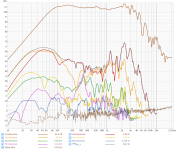
And with the grille:
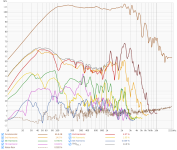
Next, I tried to support the grille cloth somewhat by holding a couple hardwood dowels across its face:
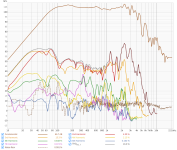
I couldn't tell from where I was standing during the previous tests, but it turns out that the grille cloth does move quite a lot. Tentative conclusion: The motion of the cloth is a factor, at least at lower frequencies.
I also tested two lower drive levels. Here's ~2.83V RMS (~1W into 8 ohms) without the grille:
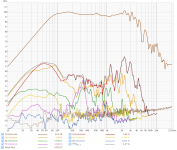
And with the grille:
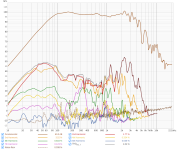
Still some difference, but smaller than at 6.3V.
Now ~0.89V RMS (~0.1W into 8 ohms) without the grille:
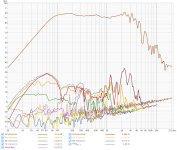
And with the grille:
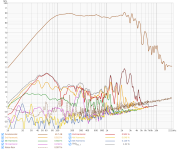
Seems to be no clear difference at this level. Note that 0.1W is still moderately loud in the context of home music listening—around 88dB mid-band at 1 meter in half space.
- There's a passive filter network between the amp and woofer. I filtered the test signals to keep the voltage at the woofer terminals approximately constant up to ~2kHz, but the woofer's distortion profile is still affected by the higher driving impedance.
- I put a piece of reticulated foam in the pole piece vent. I initially thought that this might help reduce the distortion spike around 300Hz (which seems to be related to the vent and the cavity behind the dust cap), but it mostly just increased the LF distortion a bit.
- I used multiple sweeps to suppress noise.
- I used a different USB audio interface (probably not much effect).
First, no grille at approx. the same drive level as before (~6.3V RMS at the woofer terminals; ~5W into 8 ohms):

And with the grille:

Next, I tried to support the grille cloth somewhat by holding a couple hardwood dowels across its face:

I couldn't tell from where I was standing during the previous tests, but it turns out that the grille cloth does move quite a lot. Tentative conclusion: The motion of the cloth is a factor, at least at lower frequencies.
I also tested two lower drive levels. Here's ~2.83V RMS (~1W into 8 ohms) without the grille:

And with the grille:

Still some difference, but smaller than at 6.3V.
Now ~0.89V RMS (~0.1W into 8 ohms) without the grille:

And with the grille:

Seems to be no clear difference at this level. Note that 0.1W is still moderately loud in the context of home music listening—around 88dB mid-band at 1 meter in half space.
- Home
- Loudspeakers
- Multi-Way
- Nonlinear effects of grille cloth